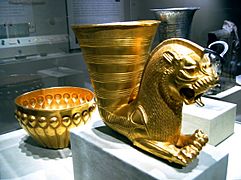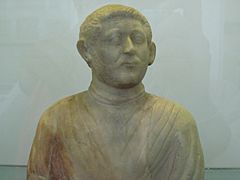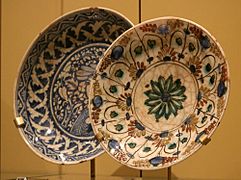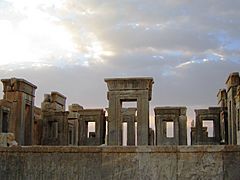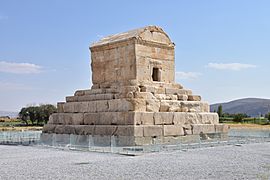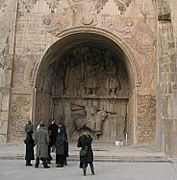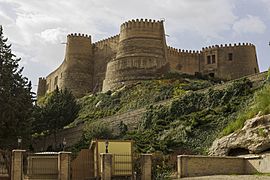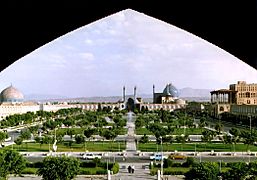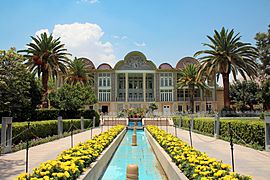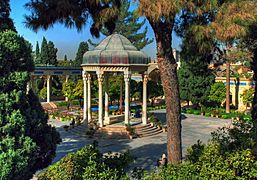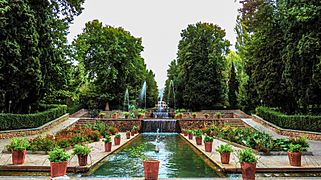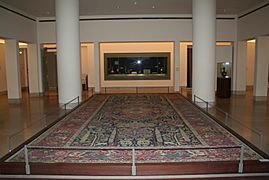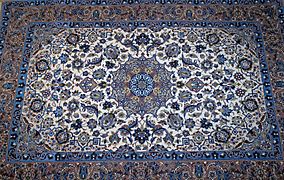Persian people facts for kids
| Total population | |
|---|---|
| ca. 90 million | |
| Regions with significant populations | |
| 49,312,834 (61–65% of total population) | |
| 618,000 | |
| 405,000 | |
| 331,000 | |
| 250,000 | |
| 238,250 | |
| 200,000 | |
| 173,760 | |
| 172,303 | |
| 160,000 | |
| Languages | |
| Persian Caucasian Tat, and Judeo-Tat), Luri | |
| Religion | |
| Primarily Shiite Muslim, also Sunni Muslims, Sufi Muslim Irreligion, Christianity, Bahá'í, Judaism, Zorastrianism |
|
| Related ethnic groups | |
| Iranian peoples, Kurds | |
The Persians are a large group of people who share a common culture, history, and speak the Persian language. Many Persians live in Iran.
Sometimes, in old books, all ancient people from the Iran area were called "Persian." But not all of them were part of the Persian culture or spoke the Persian language.
Contents
Persian Culture and History
Persian culture has been important for a very long time. It has influenced many places, from ancient Greece to modern India. This is because of Iran's location and its strong empires, like the Achaemenid Empire.
Amazing Persian Art
Persian art is a mix of many styles. It took ideas from ancient civilizations like Elam and Mesopotamia. It also blended ideas from the East and West because of Iran's central location.
Persians have created many types of art. These include carpet-weaving, beautiful writing, and tiny miniature-paintings. They also made illustrated books, glass items, and metalwork. Other arts include pottery, mosaics, and textile design.
-
5th-century BC Achaemenid gold vessels. Metropolitan Museum of Art, New York City.
-
Ancient Iranian goddess Anahita depicted on a Sasanian silver vessel. Cleveland Museum of Art, Cleveland.
-
17th-century Persian potteries from Isfahan. Royal Ontario Museum, Toronto.
Famous Persian Literature
The Persian language has one of the world's oldest literatures. Many famous poets lived in medieval times. These include Ferdowsi, who wrote Šāhnāme, a national epic. Other famous poets are Rumi, Hafez Shirazi, and Omar Khayyam.
Not all Persian literature is written in the Persian language. Some works written by Persians in Arabic or Greek are also considered Persian literature. Also, writers from other cultures, like Turkic or Indian, have written in Persian.
Modern Persian literature also has important writers. These include Sadegh Hedayat and Forough Farrokhzad.
Grand Persian Architecture
Ancient Persian buildings are very impressive. The Achaemenid architecture was known for mixing different styles. It used ideas from Median, Assyrian, and Greek buildings.
Important Achaemenid sites include the Tomb of Cyrus at Pasargadae. The grand structures at Persepolis are also famous. Another historical site is Naqsh-e Rustam.
During the Sasanian era, many buildings were constructed. Examples include the Palace of Ardashir and the Sarvestan Palace. The Bam Citadel was a huge structure on the Silk Road. It was built around the 5th century BC.
-
Ruins of the Tachara, Persepolis.
-
The Tomb of Cyrus, Pasargadae.
-
The Sasanian reliefs at Taq-e Bostan.
Modern buildings also show ancient Persian influence. The Tomb of Ferdowsi and the Azadi Tower in Tehran are examples.
Beautiful Persian Gardens
Ancient Persian kings loved gardens. They called them paradeisos, which means "paradise." These gardens used advanced water systems. They had aqueducts and water channels arranged in patterns.
The gardens were often enclosed by walls or palaces. This made them feel like a peaceful paradise. Later, the Parthians and Sasanians added their own touches. The four-part design (čārbāq) of Persian gardens influenced gardens in the Islamic world.
Today, you can see these traditional gardens. Famous examples include the Eram Garden and the Fin Garden.
-
Tomb of Hafez, Shiraz.
Persian Music and Instruments

Music was important in ancient Persian courts. The Sasanian music era has more details about its music. It was especially important in Zoroastrian rituals. Sasanian music was very influential and shaped later music styles.
Iranian music uses many special instruments. These include the bowed spike-fiddle kamanche and the goblet drum tonbak. Other instruments are the flute ney and the large frame drum daf. The hammered dulcimer santur and long-necked lutes like tar are also used.
Wonderful Persian Carpets
Carpet weaving is a key part of Persian culture. Persian rugs are known as some of the most detailed handmade artworks.
Ancient Persian carpets were highly valued. The Greek historian Xenophon wrote about the beautiful carpets made in the city of Sardis. Another writer, Athenaeus of Naucratis, described a "delightfully embroidered" Persian carpet.
The Pazyryk carpet is the world's oldest known carpet. It dates back to the 4th century BC. It shows designs from Assyrian and Achaemenid art.
-
A Persian carpet kept at the Louvre.
Images for kids
-
A bas-relief at Naqsh-e Rustam depicting the victory of Sasanian ruler Shapur I over Roman ruler Valerian and Philip the Arab.
-
One of the first actions performed by Shāh Ismā'īl I of the Safavid dynasty was the proclamation of the Twelver denomination of Shīʿa Islam as the official religion of his newly-founded Persian Empire.
-
Old Persian inscribed in cuneiform on the Behistun Inscription.
See also
 In Spanish: Persas para niños
In Spanish: Persas para niños


